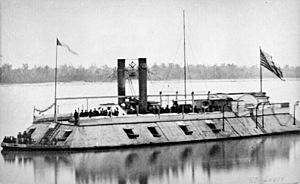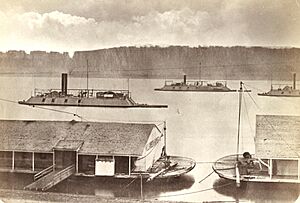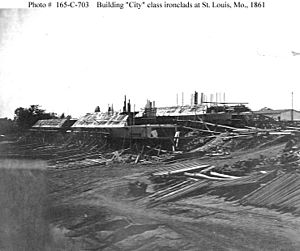City-class ironclad facts for kids
The Pook Turtles or City-class gunboats were special warships. They were built for the Mississippi River during the American Civil War. People sometimes called them "Eads gunboats" too. These seven ships were the first ironclad warships built for the United States.
They were designed by Samuel M. Pook and built by James Buchanan Eads. Eads was a rich businessman from St. Louis, Missouri. He risked his own money to help the Union side.
These gunboats became the main part of the US Army's Western Gunboat Flotilla. Later, this group joined the US Navy. The Eads gunboats fought in almost every major battle on the upper Mississippi River. They were used from their first fight at the Battle of Fort Henry until the war ended.
Contents
How the Gunboats Started
At the start of the Civil War, James B. Eads offered his salvage ship, Submarine No. 7, to the government. He thought it could be turned into a warship for the rivers. He wrote to the Secretary of the Navy, Gideon Welles. Eads explained that his boat's hull was divided into many watertight sections. This meant it could take many hits without sinking.
Since river defense was the Army's job, Welles sent the letter to the Secretary of War, Simon Cameron. Cameron then passed it to Major General George B. McClellan. McClellan was in charge of defending the Ohio and Mississippi Rivers.
Around the same time, a naval officer named Commander John Rodgers joined McClellan's team. Rodgers's job was to get gunboats. He could either convert civilian boats or have new ones built. Eads's idea fit perfectly with Rodgers's orders. So, McClellan sent Rodgers to St. Louis to meet Eads.
Rodgers didn't like Submarine No. 7. But his boss, Major General John C. Frémont, disagreed. Fremont took over from McClellan. Even though Rodgers first opposed Eads's boat, the two men worked well together. This was the start of their important partnership.
The Pook Turtles Are Born
Rodgers and Eads worked together to figure out what the new armored gunboats needed. Rodgers knew what made a warship good. Eads knew about river boats and how to build them quickly.
They decided the gunboats needed:
- Strong armor to stop cannonballs.
- Enough speed to move against the river current.
- A shallow bottom so they wouldn't get stuck.
- Many guns to scare the enemy.
They also needed good living spaces for the crew. Sailors would be fighting inside the hot, armored ships.
Rodgers asked for help from John Lenthall, a Navy ship designer. Lenthall gave some early plans but was too busy with ocean ships. He suggested Samuel M. Pook, who designed river boats and was working in Cairo, Illinois.
Pook designed a ship that could carry 13 guns but only needed six feet (1.9 meters) of water. It could go eight knots (about 9 mph). The ships had 2.5 inches (64 mm) of armor on their main gun area (casemate). The pilot house had half that much armor.
To make them fast and shallow, the boats were very wide for their length. They had three bottom sections (keels). A single paddle wheel at the back pushed them. Armor protected the paddle wheel from the front and sides.
Each ship was 175 feet (53 meters) long and 51 feet (15.5 meters) wide. Their sides sloped, like the famous Confederate ship, CSS Virginia. When the ships were finally in the water, they looked a bit strange. Farm boys who saw them called them "Pook's Turtles." The nickname stuck!
Eads won the contract to build seven of these boats. He bid $89,600 per ship and promised to finish them by October 10, 1861. Changes during building made them cost more than double. But by January 1862, all seven were ready for the Army.
The seven gunboats were named after cities:
- USS Cairo
- Carondelet
- Cincinnati
- Louisville
- Mound City
- Pittsburg
- St. Louis (later renamed Baron De Kalb)
The first four were built in Carondelet, St. Louis. This was a good spot because St. Louis had shipyards, machinery, and skilled workers. It was also right on the Mississippi River, so the boats could start fighting quickly. The other three were built at Mound City.
Ship Design and Features
Guns and Weapons
The City-class gunboats had places for 13 guns.
- Three gunports faced forward.
- Four were on each side.
- Two faced backward.
When they first started, most ships had:
- Six 32-pounder guns.
- Three 8-inch Dahlgren smooth bore guns.
- Four 42-pounder army rifles.
St. Louis (later Baron De Kalb) was a bit different. It had seven 32-pounders and two 8-inch Dahlgrens. Some also carried a small 12-pounder boat howitzer. The types of guns changed later in the war.
Armor Protection
The main armor on the gunboats was 2.5 inches (64 mm) thick. These iron plates were 13 inches (33 cm) wide. The total armor weighed 75 tons (68 tonnes).
Pook's first design only put armor on the sides near the engines. But Commander Rodgers added armor to the front gun area. The back gun area, the hull (bottom), and the deck were not protected. After the battle of Fort Pillow, another 47 tons (43 tonnes) of armor were added. They also added railroad iron to the front and back to protect against ramming.
Engines and Power
The engines were designed by Thomas Merritt. A large 22-foot (6.7 m) paddlewheel pushed the ship. Two steam engines, placed on opposite ends of the axle, powered it. Five boilers, each 36 inches (0.91 m) wide and 24 feet (7.3 m) long, made the steam.
At first, the engines were placed too low. This made them work poorly. To fix this, the steam drums were moved to the top of the boilers. This helped them work better, but it meant they were not fully protected anymore.
Battles and Operations
The City-class gunboats fought in many important battles.
- Battle of Fort Henry (February 6, 1862): Several gunboats fought here before their crews were even full. They won completely by themselves.
- Battle of Fort Donelson (February 14, 1862): Four gunboats attacked the fort. They were all damaged and had to leave the fight. However, their armor saved many lives.
- Battle of Island Number Ten (April 7, 1862): Two gunboats helped the Army trap Confederate soldiers. They sailed past enemy guns at night, showing a new way to get around forts. The Confederates surrendered to the gunboats.
- Fort Pillow (April 14 – June 4, 1862): The gunboats helped protect mortar boats that were bombing the fort.
- Battle of Plum Point Bend (May 10, 1862): Confederate ram ships surprised the gunboats. Two gunboats were badly damaged and had to run aground to avoid sinking.
- Battle of Memphis (June 6, 1862): Less than a month later, the gunboats met the Confederate rams again. This time, they were ready. Four City-class gunboats helped destroy eight Confederate rams. The gunboats were not damaged at all.
- Battle of St. Charles (June 17, 1862): During a trip up the White River, a Confederate shot hit USS Mound City. It went through the armor and blew up the steam drum. Almost the entire crew was killed or badly burned by the escaping steam.
- Vicksburg (July 1, 1862): The gunboats tried to capture Vicksburg with little Army help, but failed.
- Yazoo River Encounter (July 17, 1862): The armored CSS Arkansas attacked USS Carondelet. Carondelet was damaged and ran aground. Arkansas then sailed past the rest of the Union fleet.
- Vicksburg Campaign (Late 1862 - 1863): The gunboats, now part of the Navy, helped the Army capture Vicksburg.
- USS Cairo Sinks (December 12, 1862): On a scouting trip, USS Cairo hit two "torpedoes" (now called mines) and sank. No one died. It was the first ship sunk by mines in the war.
- Chickasaw Bayou (December 28–30, 1862): Gunboats supported the Army's attack, which failed.
- Fort Hindman (January 11, 1863): Gunboats helped destroy the fort, leading to a Union victory.
- Yazoo Pass Expedition (February 6 – April 12, 1863) and Steele's Bayou Expedition (March 14–27, 1863): Gunboats tried to bypass Vicksburg's defenses by going up small rivers. These trips failed because the ships were not good for narrow, winding waterways.
- Running Vicksburg Batteries (April 16–17, 1863): Four City-class gunboats sailed past the strong Confederate forts at Vicksburg at night. Most only got minor damage. This helped General Ulysses S. Grant move his army to attack Vicksburg from the south.
- Battle of Grand Gulf (April 29, 1863): Gunboats bombed Confederate forts at Grand Gulf, Mississippi. They couldn't completely silence the forts, so Grant had to change his plans.
- Siege of Vicksburg Ends (July 4, 1863): After Grant's army surrounded Vicksburg, the Navy controlled the rivers. This was a key part of the campaign that led to Vicksburg's surrender.
- Red River Expedition (May 4–17, 1863): One gunboat went up the Red River to capture Alexandria, Louisiana.
- USS Baron De Kalb Sinks (July 13, 1863): After Vicksburg fell, USS Baron De Kalb (formerly St. Louis) was sunk by two Confederate torpedoes in the Yazoo River.
- Red River campaign (1864): The remaining five gunboats took part in this campaign. They almost got stuck because the water levels dropped. This was their last major action.
All five surviving gunboats were sold for scrap metal shortly after the war ended.
How Good Were the Gunboats?
The City-class gunboats were very good for their time. They had strong guns, good protection, and could move well. Few other ships of that era could do all three so well. However, they did have some weaknesses.
- Weak Hulls: Their hulls (bottoms) were easily damaged. If hit, there was no way to seal off the damaged part. This made them easy targets for mines (like Cairo and Baron De Kalb) and ramming (like Cincinnati and Mound City).
- Armor Gaps: The deck and the back of the ship had no armor. This made them open to shots coming down from above (plunging fire), which happened at the Battle of Fort Donelson. Also, the steering cables were not covered, so they were easily hit.
- Steam Safety: Like all ships then, they had no way to control steam if the boilers were hit. The Mound City disaster, where steam killed most of the crew, was a terrible example of this.
- Steering Issues: Their unique three-keel design and covered paddlewheel made them hard to steer in some ways. They couldn't back up against the current. This affected how they were used in battles like Island Number Ten and Memphis.
The USS Cairo Today
The wreck of USS Cairo was found in 1956. It has been brought up from the river and is now on display. You can see the gunboat and many items from it in a museum at Vicksburg National Military Park. The National Park Service takes care of it.






